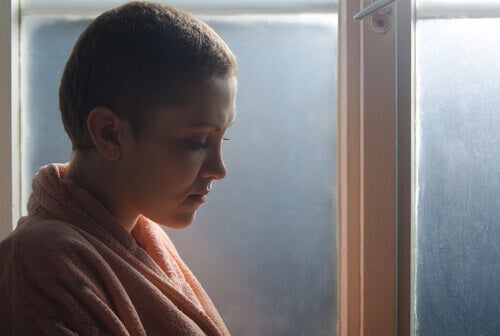Do women suffer more when diagnosed with cancer?This is the question we will try to answer from studies on mood swings and anxiety in female cancer.
This will help us determine whether the fight against cancer from a gender perspective can be beneficial for those who need it.
- Cancer.
- In one of its various forms.
- Is a stressful situation that can affect all aspects of the life of those who suffer from it.
- And there are many factors that can influence the experience of cancer: family and social support.
- Age.
- Available resources.
- Etc.
In addition, the scientific literature has shown that sex can also influence the suffering of the person with this disease.
Susceptibility to cancer is different between men and women, and its nature may be relevant to understanding why a gender perspective is needed.
Borrs (2015) showed that gynecological tumors, including breast cancer, account for 40% of all tumors in women; in men, 22% of tumors are attributed to prostate cancer, followed by lung and colorectal cancer.
We also find differences in the survival rate of cancers experienced by men and women. In fact, in the most typical female cancer, breast cancer, the survival rate is 83. 8% five years later (in Spain).
However, although survival in prostate cancer is 84. 7%, in lung cancer these odds are reduced to 10%. Lung cancer is responsible for 50% of all male tumors. As a result, women with cancer appear to die less than men with lung cancer. same disease, although the conditions are not the same.
The fact that breast cancer is one of the main causes of death in women is postulated as relevant for its treatment, the conditions vary and, therefore, the requirements of each person are also different.
The specific case of breast cancer, more experienced by women, also involves a number of very different characteristics in which gender, apprehending gender as a social and cultural category, seems to have something important to say.
According to Caniaali, Goncaalvez, Worse, Costa and Costa (2012), breast cancer involves lifestyle changes caused by physical discomfort and changes in the concept of self-image.
These authors observed that women with breast cancer also have low self-esteem and a significant decrease in their libido.
Other studies presented by these authors suggest that there is a prevalence of clinically significant symptoms of anxiety and depression in breast cancer patients, who have symptoms such as tension, non-specific fear and diffuse anxiety.
Olivares (2004) studies the psychological aspects of gynecological cancer. It has been shown that one, anxiety, is a predictor of recovery in women after surgery.
Anxiety in women’s cancer is relevant because, according to this researcher, patients with higher levels of preoperative anxiety had more pain and discomfort in the postoperative period, needed more medication and longer hospitalizations.
Salmon (1992), as well as Olivares (2004), find a positive relationship between presurgical and post-surgical anxiety, and a positive linear association with postoperative depression.
To understand anxiety in female cancer, it is necessary to study the specific concerns of a woman with cancer.
Although this seems obvious and the disease itself is a source of stress and fear, the truth is that studies such as Mota, Aldana, Bohórquez, Martínez and Peralta (2018) expose the factors that generate anxiety. in women with cancer. Among them we can highlight:
Depending on the timing of the disease and the type of cancer, anxiety is different in women, for example, those who have undergone a mastectomy refer to frustration, sadness, anxiety and depression.
Breast cancer anxiety, according to the authors, often restricts women’s social, family and personal lives.
In addition to anxiety in female cancer, motivated by the disease itself, in the case of gynecological cancers, physiological changes play a key role in their subsequent well-being.
Self-confidence, emotional stability, strength, positive affectivity and self-esteem determine a person’s well-being during their life cycle, according to García-Viniegras and González (2007). After cancer, many women don’t have any of these factors.
Sebastian, Manos, Bueno y Mateos (2007) claim that while cancer usually includes surgery and in many cases leaves physical scars, physical changes in breast cancer have important psychosocial connotations for women.
This is due to the importance given to breasts to understand the female identity of women, many women think, for example, that losing a breast also means losing their femininity.
In addition, breasts also seem to play a crucial role in the ability to attract and maintain sex and are almost always affected after surgery or treatment.
Sadness, image, and sexual problems and anxiety in female cancer can occur in all gynecological conditions, not just breast cancer.
Olivares (2005) talks about depressive symptoms, anxiety and chronic sexual problems five years after treatment in women with cervical cancer, 55% of women with sexual difficulties and 33% of women who no longer have sex after endometrial cancer.
Each medical treatment carries different circumstances for the patient, we have observed that fear, sadness, anxiety and lack of self-esteem are common in gynecological cancers.
Not only that, but these changes in a person’s psychological level can influence the development of the disease, so it seems appropriate to respond differently to the psychological and emotional needs of women with cancer.
Treatment should not only include chemotherapy, but also measures to help control or combat anxiety about interventions. Psychoeducative programs to dispel harmful myths, such as the one that believes a woman’s sexuality and femininity are in her breasts or vagina, and include confidence and self-esteem. estimates it as one of the goals of the treatment itself.
The ultimate goal should be well-being, not only physical, but also women’s overall health.

